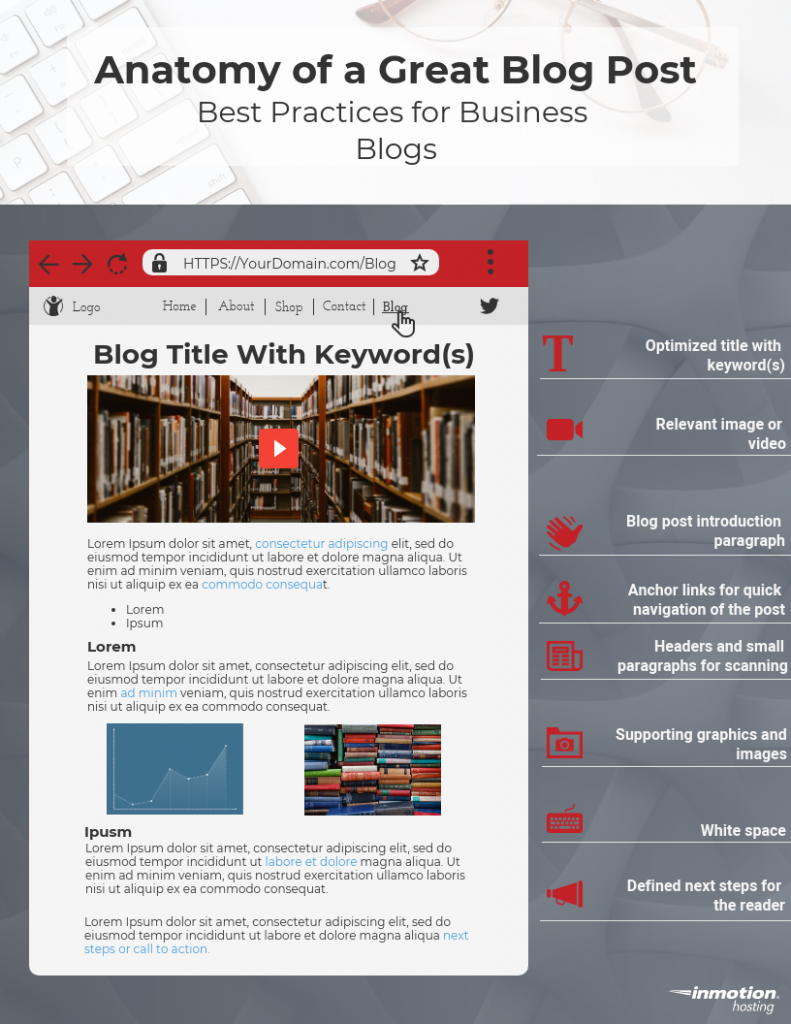
You’ve heard it time and time again. To increase traffic and business to your website, create a blog. However, if you’re going to create a blog, you need to make sure you’re implementing it correctly in order to reap the benefits. This article will walk you through the best practices for business blogs so you can blog with your best foot forward.
- Keyword Research
- Competitor Research
- Identifying Topics
- Consistent Quality Content
- Anatomy of a Great Blog Post
Launch your web presence quickly and easily with our Shared Hosting plans.
Keyword Research
Before you jump into content creation, it’s important to be aware of the relevant keywords you should incorporate into your blog posts. Your keyword research should include identifying both short and longtail keywords. Identifying the keywords your audience is using to search for similar, relevant services in search engines will help you discover topics to write about.
Remember, the purpose of your blog is to attract more traffic to your website. If you’re using relevant keywords in your blog posts, users searching those keywords will land on your blog, and thus your business website.
Also, don’t use branded keywords too much. Branded keywords are keywords with your business name, like Joe’s Auto Shop instead of just Auto Shop. I know, we mentioned above that the purpose of a blog is to attract customers, however, the idea is to establish your business as a thought leader in a particular industry. This will help build trust with the online world and increase your business.
Think about it, how much trust would you put in a business that uses its blog to constantly promote its own products. You probably wouldn’t regard them as a trusted industry authority and may not even believe the marketing around their products. To find the right balance between branded keywords and industry keywords, look at it from the perspective of the customer. How often would you like to read branded content versus general thought pieces?
Competitor Research
Once you have your relevant keywords and a tentative list of topics, try searching for them in a search engine. Take note of the websites that load on the first page of the search engine. Are they direct competitors, editorial websites, or affiliate sources? In addition to identifying the type of website that is ranking for a particular keyword, also take note of the content. How long is the content? Is it accompanied by images, videos, and/or graphics? Are there holes in the articles?
The content review isn’t to completely copy their content, but to take note of the type of content that is ranking high. If they have images and graphics, your article should have images and graphics too. If there are holes in their articles, your article should address the keyword and fill the holes.
Identifying Topics
Both your keyword and competitor research will help you identify topics to tackle on your blog. You can figure out popular topics and create better quality content to help users. You can also identify holes in particular articles and work to create content that addresses the holes. You can even use the keyword and competitor research to discover topics that others have not written about yet.
In addition to the above, brainstorm ideas that anticipate changes in the market or address future needs for customers. For example, if you’re a landscaping business, you could give advice for the next season and how people can prepare their yards for the season change.
SEO is an important part of increasing your business online. Are you correctly implementing SEO best practices? Use this SEO checklist to make sure you’re staying on top of your SEO implementation.
Consistent Quality Content
Though there is a lot of emphasis on keyword research and competitor content review, however, it’s important to remember that all content published on your blog needs to be quality and helpful.
Google can detect keyword stuffing and knows when an article is solely for ranking and not necessarily a helpful piece of content. Think of Google as an online library. A library is not going to promote content that isn’t useful to its readers. Google is the same way.
Your content must be useful for it to attract an audience and rank. The easiest way to ensure that your content is useful is to only use keywords naturally throughout the piece.
Imagine that you’re talking to someone about the topic — how often do you really say the keyword? Not that often, right? You may mention it a few times but the bulk of your content is explaining the topic in more detail and maybe evening giving examples. Your blog posts should have the same flow as well.
In addition, you must post your content regularly. Using the library example from above, are you going to continue to visit a library that never has new books? Post content on your blog regularly to show your audience and Google that you’re an authority and trusted source in a particular industry.
Anatomy of a Great Blog Post
When writing a blog post, in addition to the flow of the writing, you should also be aware of the flow of the blog elements as well. To keep readers engaged, break up the text, add images, and make sure to link to relevant resources. This infographic will show you considerations for a great blog post.

Get your business online quickly with our easy-to-follow ebook!
Now that you know how the best practices for business posts, and have the blueprint for a great blog post, learn more about optimizing your website for business growth with our Web Design Education channel!
Do you want to own a small business but don’t know where to start?
Download the FREE Business Startup Checklist from InMotion Hosting.